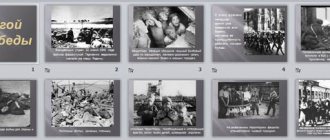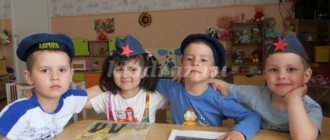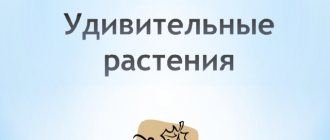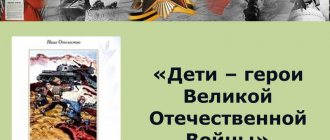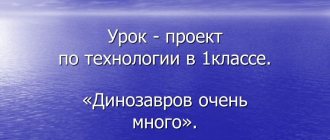Class hour “Children of War” with a presentation for elementary school, grades 3-4
Summary of extracurricular activities for May 9 - Victory Day with presentation.
Theme: “Children of War.” Primary school Author: Tsareva Angela Ivanovna, student of Novosibirsk Pedagogical College No. 2, specialty: 02/44/02. Teaching in primary school. Description of the material: The war did not spare anyone; it hit children just like adults - with explosions, hunger, and cold. Next - the howling of sirens, bombings, shelters, burned and destroyed houses, the loss of loved ones. But in this terrible time, children were not only victims, they became warriors, bravely went to defend their homeland, their mothers, brothers and sisters. This extracurricular activity scenario allows students to become acquainted with children who overcame the difficulties of harsh wartime.
Participants: students in grades 3-4, their parents, teachers. Form of delivery: class hour. Methods: verbal, visual, practical. Goal: to cultivate respect for history and the people who participated in the Great Patriotic War, love for the Motherland, pride in the victory of the Russian people, patriotic feelings through vivid examples of heroism and the lives of their peers during the war. Objectives: Educational: - introduce students to the role of children during the war. Developmental: - Develop the best qualities of a person: patriotism, citizenship, pride in one’s homeland, desire for peace - Develop students’ interest and respect for the heroic events of the past. Educational: - to instill in students a sense of patriotism, love for the Fatherland, respect for children of war - participants in hostilities through stories about the historical past Educational tools: A4 sheets, colored paper, felt-tip pens, pens, pencils, triangle envelopes for reflection, phonogram of the message “From the Soviet Information Bureau”, video “Children of War”, phonogram “Victory Day”, presentation of m/m, TSO: computer, interactive board.
Course of extracurricular activities:
Organizing time.
Teacher: Hello, guys! How are you doing? What about your mood? Are you excited about the arrival of the warmest month of spring? Students : greet the teacher, answer questions.
Introduction to the topic of the lesson.
Teacher: Every country, every people has its own holidays.
Please remember what holiday is coming very soon. Students: May 9 - Victory Day.
Teacher: Well done! Right. Today our lesson is dedicated to this great day! May 9th! Victory Day! Namely, Children of War. (Slide 1) Teacher: You were born and raised in a peaceful land. You know well how spring thunderstorms make noise, but you have never heard the thunder of a gun. This year we celebrate the 73rd anniversary of the liberation of our country from the Nazi-German invaders. You see how new houses are being built in the village, but you have no idea how easily houses are destroyed under a hail of bombs and shells. You know how dreams end when you are woken up, but it’s hard for you to believe that ending a human life is as easy as a cheerful morning dream. You wake up peacefully and smile at your parents, the children woke up just as happily on that fateful day. And suddenly... (The soundtrack of the message “From the Soviet Information Bureau” sounds).
This was the day the war began: June 22, 1941.
(slide 2) Teacher: So unexpectedly, on an ordinary summer day on June 22, 1941, the most terrible, bloodiest of all the Great Patriotic Wars began. You can count how many years, months and days the war lasted, how much was destroyed and lost, but how can you count the amount of grief and tears that this terrible war made you shed. The war took a terrible toll on children's destinies, It was difficult for everyone, difficult for the country, But childhood was seriously mutilated: Children suffered grievously from the war... They were called CHILDREN OF WAR. What do we know about them? Teacher: Guys, do you know anything about WWII children? Students: tell the information they have about children of the Great Patriotic War. Teacher: Includes a video clip “Children of War”
Children of War are all children born between September 1929 and September 3, 1945.
Now they are veterans and have the status of “Children of the Great Patriotic War.” The country's factories were left without workers. During the harsh days of the war, children stood next to adults. Schoolchildren earned money for the defense fund, collected warm clothes for front-line soldiers, worked in military factories, stood on duty on the roofs of houses during air raids, and gave concerts to wounded soldiers in hospitals. (slide 3) Teacher: Times were hard.
Children lost parents, brothers and sisters. Sometimes frightened children sat next to the cold bodies of their dead mothers for several days, waiting for their fate to be decided. At best, they were waiting for a Soviet orphanage, at worst - in fascist dungeons. Not all adults could survive the horrors of concentration camps; hunger, cold, backbreaking labor, and often torture awaited children in captivity (slide 4-5) Getting to know the children participating in the war.
Teacher: Many children fought against fascism with arms in hand, becoming sons and daughters of regiments. According to various sources, up to several tens of thousands of minors took part in the fighting during the Great Patriotic War. “Sons of the regiment”, pioneer heroes - they fought and died along with adults. For military merits they were awarded orders and medals. Five minor fighters of the Great Patriotic War were awarded the highest award - the title of Hero of the USSR. All - posthumously, remaining in textbooks and books by children and teenagers. Everyone should know these heroes by name. (slide 6) Today I invite you to remember them. This is Lenya Golikov (slide 7)
Participated in 27 combat operations.
In total, he destroyed: 78 Germans, two railway and 12 highway bridges, two fodder warehouses and 10 vehicles with ammunition. Accompanied a convoy with food to besieged Leningrad. Valya Kotik (slide
Since August 1943 he acted in a partisan detachment, he was wounded twice. On October 29, 1943, while on patrol, he noticed punitive forces who were about to launch a raid on the detachment. Having killed the officer, he raised the alarm, and the partisans managed to repel the enemy. Participated in the explosion of 6 railway trains and a warehouse.
Marat Kazei (slide 9)
Scout at the headquarters of a partisan brigade. Penetrated into enemy garrisons and delivered valuable information to the command. Returning from reconnaissance and surrounded by the Germans, he fought until the last bullet, and when only one grenade remained, let the enemies get closer and blew them up... and himself.
Borya Kuleshin (slide 10)
Served on the ship. On board the ship, Borya gives the anti-aircraft gunners heavy clips of shells - one after another, without knowing fatigue, without fear, and in the intervals between battles he helps the wounded, takes care of them. Borya spent more than 2 heroic years at sea, on a warship, fighting the Nazis for the freedom of our Motherland.,
Arkady Kamanin (slide 11)
The youngest pilot of the Second World War.
One day the cockpit glass was broken by an enemy bullet. The pilot was blinded. Losing consciousness, he managed to hand over control to Arkady, and the boy landed the plane at his airfield. One day, from above, a young pilot saw our plane shot down by the Nazis. Under heavy mortar fire, Arkady landed, carried the pilot into his plane, took off and returned to his own. Valya Zenkina (slide 12)
The Nazis forced Valya to sneak into the Brest Fortress to convey to its defenders the demand to surrender.
Valya made her way into the fortress, talked about the atrocities of the Nazis, explained what weapons they had and their locations, and stayed to help our soldiers. During the day she bandaged the wounded, and at night she collected weapons from the recent battlefield and dragged them to the fortress. After the evacuation of women and children from the besieged fortress, she continued to fight in the partisan detachment. She fought bravely, along with adults. Volodya Dubinin (slide 13)
13-year-old partisan Dubinin managed to become the eyes of the partisan detachment.
The commander of the group of young scouts, pioneer V. Dubinin, went to the surface seven times. He left the quarries and made his way back almost in front of the German sentries. After the liberation of Kerch on January 4, 1942, Volodya volunteered to help sappers in clearing mines from the approaches to the quarries. The mine explosion killed the sapper and Volodya Dubinin, who was helping him. Volodya Shchebatsevich (slide 14)
The release of prisoners of war was the main task for everyone for the Minsk underground.
Volodya was wounded several times. Once, using forged documents, they took a whole truckload of prisoners of war to the partisans. They were given away by their own. Volodya was arrested by the police. Interrogations, torture. My whole body hurts, I feel chills, I have no strength to get up from the cold stone floor. But he didn’t tell the Nazis anything. Zina Portnova (slide 15)
While working in a German canteen, at the direction of the underground, she poisoned the food.
During the proceedings, wanting to prove to the Germans that she was not involved, she ate poisoned soup. Miraculously, she survived. Since August 1943, Zina has been a scout for a partisan detachment. In December 1943, following a denunciation from a traitor, she was arrested. During one of the interrogations, Zina grabbed a pistol from the table and shot point-blank at the Gestapo man. The officer who ran in to hear the shot was also killed on the spot. Zina tried to escape, but the Nazis overtook her... Valera Volkov (slide 16)
Member of the partisan movement operating in Sevastopol.
He loved poetry and often read to Mayakovsky’s comrades. He himself composed notes and articles for the handwritten newspaper-leaflet “Trench Truth.” In July 1942, Valery, together with a handful of brave Marine reconnaissance officers, repelling an enemy attack and covering the withdrawal of military units from Sevastopol, died heroically, throwing a bunch of grenades under an advancing tank. Marx Krotov, Albert Kupsha, Kolya Ryzhov (slide 17)
Friends actively helped the partisan movement in the Leningrad region.
They collected food and weapons and handed them over to the partisans, leading the Red Army soldiers out of encirclement. On instructions from the partisan commander, the boys made their way to the Nazi airfield and, giving light signals, guided our bombers to the target. Enemy planes were destroyed. Vasya Korobko (slide 18)
Was a scout and messenger, and later a demolition worker.
The partisans entrusted Vasya with a serious task: to become a scout in the enemy’s lair. At the fascist headquarters, he lights the stoves, chops wood, and he takes a closer look, remembers, and passes on information to the partisans. He derailed 16 trains with Nazi soldiers and military equipment, disabled 10 locomotives, and personally destroyed about 400 Nazis. Yuta Bondarovskaya (slide 19)
Joined the underground partisan brigade as a scout.
Dressed as a beggar boy, she collected information from the villages: where was the fascist headquarters, how it was guarded, how many machine guns there were. She distributed Sovinformburo reports and participated in the detachment’s combat raids behind enemy lines. At the end of one exceptionally difficult transition, the partisans were forced to fight the Nazis. This fight was the last for Utah. Sasha Kondratiev (slide 20)
Together with his mother, Sasha sheltered soldiers who escaped from captivity, looked after wounded Red Army soldiers and was always eager to get into a real battle.
He gave the enemy this real fight. Not far from the village there was an airfield from which German planes took off into the sky. Taking cover nearby with a light machine gun in his hands, Sasha waited... And when the Messer-Schmitt rose into the air, gaining altitude, Sasha shot him with machine-gun bursts. The Nazis tracked down the young patriot and captured him. Lara Mikheenko (slide 21)
In August 1943, Lara, along with adults, takes part in blowing up one of the bridges over the Drissa River.
At the beginning of November 1943, Lara was arrested. Lara had a hand fragmentation grenade in her coat, which she decided to use. However, for some unknown reason, the grenade thrown by the girl at the patrol did not explode. Galya Komleva (slide 22)
The young messenger brought tasks from the partisans to her counselor, and forwarded her reports to the detachment along with bread, potatoes, and food, which were obtained with great difficulty. Together with her friends, Galya wrote leaflets and scattered them around the village at night. The Nazis tracked down and captured the young underground fighters. They kept me in the Gestapo for two months. They beat me severely, threw me into a cell, and in the morning they took me out again for interrogation. Galya didn’t say anything to the enemy, didn’t betray anyone.
Making posters in memory of the Great Patriotic War.
Teacher: Children fought the horror of fascism, adults fought. (phonogram “Victory Day”)
Victory has come!
Long-awaited, with tears in my eyes. (slide 23)
It came thanks to the unity of the Russian people, thanks to the friendship of the peoples of Russia, our grandfathers dreamed of a happy future for their children and these dreams came true. We smile and do not starve, thanks to the soldiers of the Great Patriotic War, thanks to the children of war. Let us now make posters in memory of those terrible days that children and adults had to endure. We will always remember what they did for us and be grateful for our happy childhood. Students: make posters in memory of the Great Patriotic War.
A minute of silence.
(slide 24) Teacher: Think about these numbers: 9,168 children were lost every day, 382 children were lost every hour, 6 children were lost every minute, 1 child was lost every ten seconds.
If we wanted to honor every child of war with a minute of silence, then humanity would have to remain silent for 25 years. If a minute of silence was declared for every person who died in the Second World War, the world would be silent for fifty years. I ask everyone to stand up. A minute of silence. Sit down. Reflection.
Teacher: In letters to the front, the children told the soldiers how at home, in the rear, they were trying to help the front. How the soldiers needed this news before a difficult battle. Let us now write words of gratitude on triangle letters to all those thanks to whom we now live in peace and tranquility. And also write your opinion about today's lesson. (slide 25) Teacher: The lesson has come to an end.
Thanks to all. See you again! Presentation on the topic: Children of war
We recommend watching:
Extracurricular event for Victory Day, grades 3-4. Nobody is forgotten, nothing is forgotten Concert for the Great Victory Day. Scenario for 3rd grade with presentation Extracurricular event for Victory Day in 2nd grade. Bitter bread of war Extracurricular event “Songs of the war years” in elementary school with presentation
Similar articles:
Matinee for May 9 – Victory Day, 3rd grade
Extracurricular event in elementary school for Victory Day. Dramatization based on Alekseev’s story “Grandfather”
Relay race for May 9th for junior schoolchildren
Scenario of an educational game program for May 9 - Victory Day in primary school
Scenarios for May 9th for elementary school
1941-1945 through the eyes of children
In those distant years, the kids lost the most precious thing in their lives - a carefree childhood. Many of them had to stand at the machines at the factory, like adults, and work in the fields to feed their families. Many children of war are real heroes. They helped the military, went on reconnaissance missions, collected guns on the battlefield, and took care of the wounded. A huge role in the victory in the Great Patriotic War of 1941-1945. belongs specifically to children and teenagers who did not spare their lives.
Unfortunately, it is now difficult to say how many children died then, because humanity does not know the exact number of deaths, even among the military. Children-heroes went through the siege of Leningrad, survived the presence of fascists in the cities, regular bombings, and famine. Many trials befell the children of those years, sometimes even the death of their parents before their eyes. Today these people are over 70 years old, but they can still tell a lot about those years when they had to fight the Nazis. And although at parades. Dedicated to the Great Patriotic War of 1941-1945. They honor mainly the military; we should not forget the children who bore on their shoulders the hunger and cold of a terrible time.
